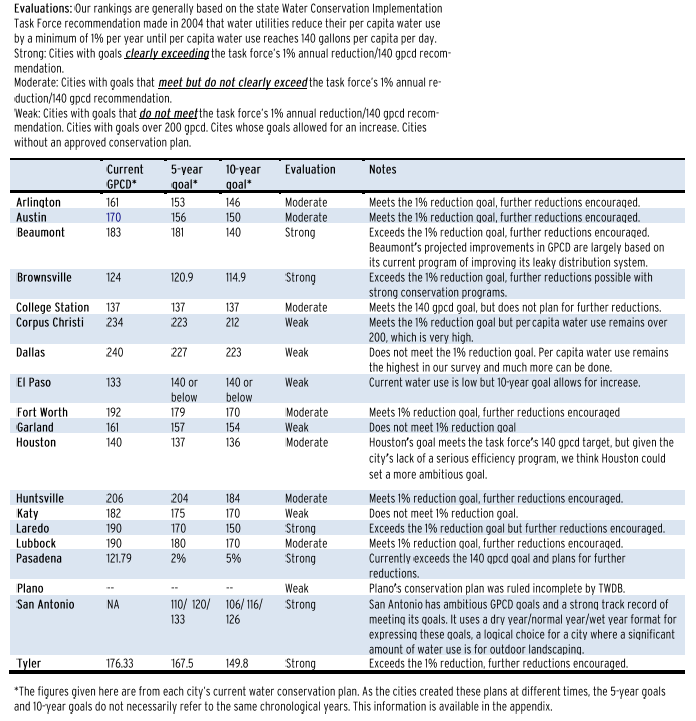Water Conservation in Texas: Good, Bad And Ugly

Perhaps the timing isn’t best (the drought has lifted and attention has drifted elsewhere) but the National Wildlife Federation and the Sierra Club released a report this week on water conservation efforts in nineteen Texas cities.
As the two groups note, the “quality and extent of water conservation programs in Texas’ cities vary considerably.” The programs range from pathetic (Corpus Christi and Dallas, for example) to very good (El Paso and San Antonio) with the rest sort-of falling in between. The goods news is that many medium and large cities are getting more serious about conservation.
Here’s a quick snapshot. (Click for larger image.)
San Antonio and El Paso aren’t inherently more virtuous; they’ve just been pushed by necessity to learn how to conserve. San Antonio has a $5.5 million conservation budget, money that goes into rebates for consumers who purchase low-flush toilets and washing machines, a four-person team that quickly fixes leaks in the system, and consumer education programs.
The city has rules on watering and landscaping. San Antonio is also the only city in the state to reinvest some of its revenue from water sales in conservation. The result is that the Alamo City has sliced per-person consumption by 100 gallons per day over the past 25 years.
Other cities are learning from San Antonio and El Paso’s example. In particular, the report gives high marks to Austin, which has the goal of reducing consumption from 170 to 146 gpcd within ten years. Austin has the best toilet replacement program in the state, each year swapping out 20,000 high-flush toilets for newer, more efficient models. The city recently redesigned its rate structure, imposing steep prices on water wasters (here’s looking at you, Lance Armstrong).
Places like Dallas and Corpus Christi, on the other hand, are frankly pathetic. Dallas, for example, has the highest water consumption rate (240 gallons per day per person) of any of the cities surveyed and shows little willingness to change. In ten years, the city’s goal is to reduce consumption to just 223 gpcd.
No wonder the “water hog” label sticks to Dallas: the powers-that-be seem more interested in chasing water in Oklahoma’s rivers and building new dams in East Texas than trying conservation.
Part of Dallas’ profligacy stems from allowing a handful of users to waste incredible amounts of water. According to the report, the top ten users in 2008 “used an astonishing 60 million gallons of water.” The average consumer uses just under 88,000 gallons each year.
The report does credit Dallas with stepping up their efforts in some areas, such as Dallas Water Utility’s awesomely-named “New Throne for Your Home” toilet rebate program.
Other highlights:
1) Houston, the fourth-largest city in nation, doesn’t have a single full-time employee working on water conservation;
2) The more water you consume in Lubbock they less you pay, a pricing structure that encourages waste;
3) College Station has a surprisingly extensive water conservation program for a city of its size;
4) Ten of the 19 cities surveyed have no restrictions on daytime watering or weekly watering schedules. Only two – El Paso and Austin – had strict rules on outdoor watering.
Read the full report.



